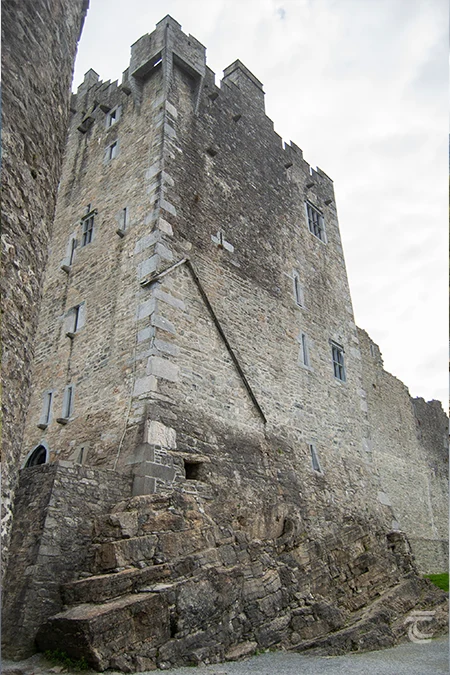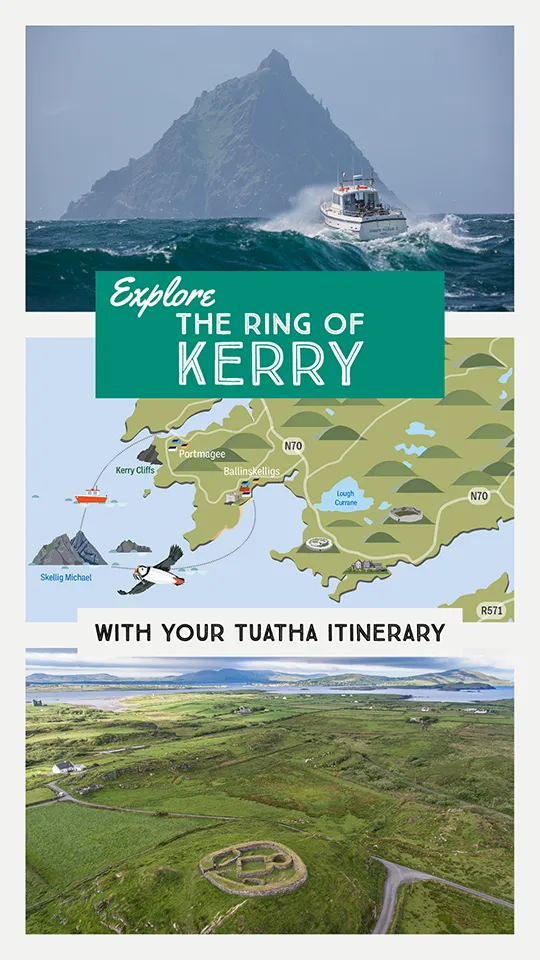Ross Castle
Set in the stunning surroundings of Killarney National Park, Ross Castle is the subject of countless postcards and the star of many tourist brochures. However, despite its almost Disney-like appearance, Ross Castle has a fascinating, and occasionally bloody, history. The name Ross Castle derives from the Irish ‘Caisleán an Rois‘, meaning ‘the Castle of the Promontory’. A perfectly descriptive name, as it stands on Ross Island, an irregular-shaped projection that extends from the eastern side of Lough Leane. Ross Castle began as a late medieval tower house, built in around 1450–1500 by the powerful O’Donoghue family who held sway over Killarney at that time. They had a large tower constructed, surrounded and protected by an exterior bawn wall. A further line of defence, most likely formed by a timber palisade and ditches, protected all the ancillary buildings like the smith, stables and homes of the garrison. The tower itself consisted of four floors. The ground floor was used largely for storage, and for the use of the garrison and serving staff. The first floor held domestic rooms for the family. The second floor had the bedrooms, while the Great Hall was in the top floor. This was where all the large public events, feasts and celebrations were held.
Throughout its history, Ross Castle has been the centre of a tug of war between competing families, and has changed hands a number of times. The first loss of Ross Castle occurred, when Ruaridhe O’Donoghue supported the Earl of FitzGerald during the doomed Desmond Wars of the late 16th century. Ruaridhe O’Donoghue was killed in 1583, and in the aftermath of the rebellion, the O’Donoghues lost everything. All their lands, including Ross Castle, were confiscated. The McCarthy Mors briefly held sway at Ross Castle, though they too would lose possession when the English Crown sought to change Munster forever, by settling with loyal protestants from England. Ross Castle was given to Sir Valentine Brown, an English land surveyor who was one of the chief administrators of the Munster Plantation. It would be the Brown family that ended up having the longest association with this castle.
By the end of the 16th century, the ambitious Munster Plantation had been largely frittered away, especially as the Nine Years War took their toll on the English grip on this part of Ireland. The McCarthy Mors retook control of Ross Castle, aided by a judgement in their favour through the Courts of Queen Elizabeth 1st. However, their success was relatively short lived. Following the Battle of Kinsale in 1601 the Brownes returned victorious and evicted the McCarthy Mors from the castle. They demolished the western side of the bawn, to allow the construction of a fortified house alongside the tower. Though time and proximity eventually softened the conflict between the McCarthy Mors and the Browns. The families became entwined through marriage, and the Browns converted to Catholicism. You can read more of their story, and the history of Ross Castle below.
For practical information about visiting this site Click Here
Set in the stunning surroundings of Killarney National Park, Ross Castle is the subject of countless postcards and the star of many tourist brochures. However, despite its almost Disney-like appearance, Ross Castle has a fascinating, and occasionally bloody, history. The name Ross Castle derives from the Irish ‘Caisleán an Rois‘, meaning ‘the Castle of the Promontory’. A perfectly descriptive name, as it stands on Ross Island, an irregular-shaped projection that extends from the eastern side of Lough Leane. Ross Castle began as a late medieval tower house, built in around 1450–1500 by the powerful O’Donoghue family who held sway over Killarney at that time. They had a large tower constructed, surrounded and protected by an exterior bawn wall. A further line of defence, most likely formed by a timber palisade and ditches, protected all the ancillary buildings like the smith, stables and homes of the garrison. The tower itself consisted of four floors. The ground floor was used largely for storage, and for the use of the garrison and serving staff. The first floor held domestic rooms for the family. The second floor had the bedrooms, while the Great Hall was in the top floor. This was where all the large public events, feasts and celebrations were held.
Throughout its history, Ross Castle has been the centre of a tug of war between competing families, and has changed hands a number of times. The first loss of Ross Castle occurred, when Ruaridhe O’Donoghue supported the Earl of FitzGerald during the doomed Desmond Wars of the late 16th century. Ruaridhe O’Donoghue was killed in 1583, and in the aftermath of the rebellion, the O’Donoghues lost everything. All their lands, including Ross Castle, were confiscated. The McCarthy Mors briefly held sway at Ross Castle, though they too would lose possession when the English Crown sought to change Munster forever, by settling with loyal protestants from England. Ross Castle was given to Sir Valentine Brown, an English land surveyor who was one of the chief administrators of the Munster Plantation. It would be the Brown family that ended up having the longest association with this castle.
By the end of the 16th century, the ambitious Munster Plantation had started to fragment, especially as the Nine Years War took their toll on the English grip on this part of Ireland. The McCarthy Mors retook control of Ross Castle, aided by a judgement in their favour through the Courts of Queen Elizabeth 1st. However, their success was relatively short lived. Following the Battle of Kinsale in 1601 the Brownes returned victorious and evicted the McCarthy Mors from the castle. They demolished the western side of the bawn, to allow the construction of a fortified house alongside the tower. Though time and proximity eventually softened the conflict between the McCarthy Mors and the Browns. The families became entwined through marriage, and the Browns converted to Catholicism. You can read more of their story, and the history of Ross Castle below.
For practical information about visiting this site Click Here

Aerial view of Ross Castle on Lough Leane • Kerry
The History of Ross Castle

A complex web of roof lines and building styles show alterations through time • Ross Castle
During the Catholic Confederacy Rebellion of the middle of the 17th century, Ross Castle was held by forces loyal to the confederacy. Lord Muskerry, uncle of the young Valentine Brown, led the defence when the Cromwellian General Ludlow arrived with more than 4,000 soldiers and a large force of calvary. Despite the forces arrayed against them, the defenders felt confident to hold their ground, until an old prophecy proved its truth. As described in this excellent account in the School’s Folklore Collection:
‘…For some time the siege continued, for no force could attempt to storm the castle owing to its position over the lake. At last it was discovered that there was an old prophesy relating to the castle – that it could never be taken unless an enemy fleet sailed over the lake. Ludlow on hearing this bethought him of a plan. He sent his scoutmaster to Kinsale and there procured the services of an eminent shipwright named Thomas Chudleigh. The materials for the fleet of heavy dredgers or lighters were procured and shipped to Castlemaine Bay. These they were taken overland to the Parliamentary camp and constructed by the Kinsale artisan.
One fine morning as the garrison awoke they were surprised to see a fleet of boats with cannon abroad sailing on the lake. All cried with one voice that the prophesy was fulfilled and that further resistance was in vain. Lord Muskerry after a fortnight’s study defence called a party and after terms were agreed on, surrendered the castle.’

A complex web of roof lines and building styles show alterations through time • Ross Castle
Ross Castle would be one of the last strongholds to fall to Cromwell in Munster.
The lands were again confiscated following the Williamite Wars, as the Browns remained loyal to the defeated King James II. The family went into exile to France, and in 1717, Ross Castle was transformed into a garrison. The Browns’ fortified home was demolished to make way for the garrison. However, the Browns knew how to play the long game, and the family regained control of their estates in the early 19th century. They had been elevated to the title of Earls of Kenmare, though by this time, the castle itself was in poor condition, and was largely abandoned.
The 2nd Earl of Kenmare, Valentine Brown, had the roof removed from Ross Castle to avoid paying taxes. The windows of the barracks were narrowed into arrow slits, to give the later building a more harmony with the medieval towerhouse. So it was that Ross Castle, once a medieval seat of power, was transformed into a romantic ruin. Helping to provide a backdrop for many picnics during the early stages of tourism to Killarney, that has thrived from the 19th century onwards.
Ross Castle was taken into the care of the state in 1970. It was in a very ruinous condition at the time, and has since undergone extensive conservation and restorations, with a focus on using original techniques and materials, such as plaster strengthened with horse hair, and the hand-cut timbers that form the wooden roof. All of this helps to create a rewardingly atmospheric and informative place to visit today. If you plan to visit, do take the opportunity to visit the lovely Innisfallen Island by taking one of the boat trips from just below the steps of Ross Castle.
Upper left: a winter view • Lower left: the barracks • Right: aerial view of the castle
Top: a winter view • Middle: aerial view of the castle • Bottom: the barracks




